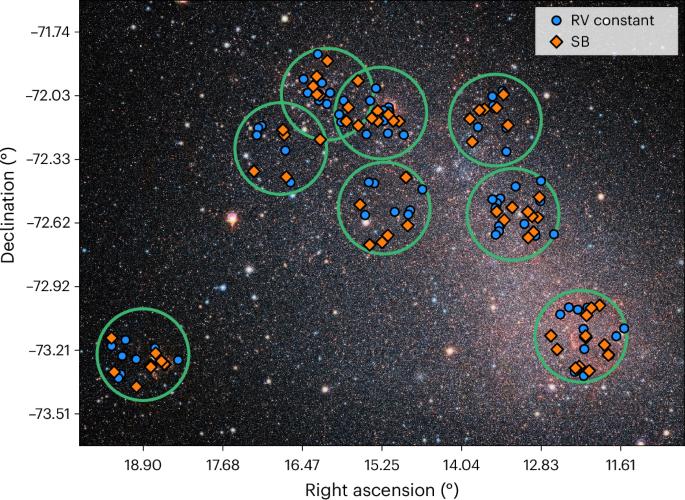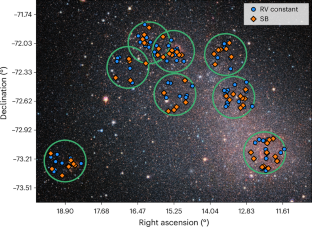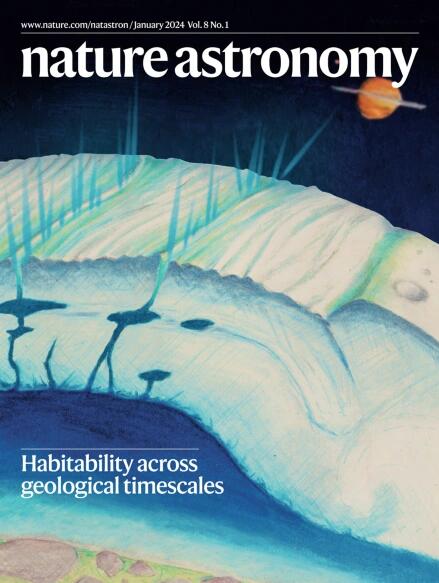A high fraction of close massive binary stars at low metallicity
IF 14.3
1区 物理与天体物理
Q1 ASTRONOMY & ASTROPHYSICS
引用次数: 0
Abstract
At high metallicity, a majority of massive stars have at least one close stellar companion. The evolution of such binaries is subject to strong interaction processes, which heavily impact the characteristics of their life-ending supernova and compact remnants. For the low-metallicity environments of high-redshift galaxies, constraints on the multiplicity properties of massive stars over the separation range leading to binary interaction are crucially missing. Here we show that the presence of massive stars in close binaries is ubiquitous, even at low metallicity. Using the Very Large Telescope, we obtained multi-epoch radial velocity measurements of a representative sample of 139 massive O-type stars across the Small Magellanic Cloud, which has a metal content of about one-fifth of the solar value. We find that 45% of them show radial velocity variations that demonstrate that they are members of close binary systems, and predominantly have orbital periods shorter than 1 year. Correcting for observational biases indicates that at least $$7{0}_{-6}^{+11}\%$$ of the O stars in our sample are in close binaries, and that at least $$6{8}_{-8}^{+7}\%$$ of all O stars interact with a companion star during their lifetime. We found no evidence supporting a statistically significant trend of the multiplicity properties with metallicity. Our results indicate that multiplicity and binary interactions govern the evolution of massive stars and determine their cosmic feedback and explosive fates. The analysis of radial velocity variations of O-type stars in the Small Magellanic Cloud reveals a large fraction of close binaries, suggesting that binary physics also plays a prominent role in the low-metallicity environment of the distant Universe.


低金属丰度的高质量近距离双星
在金属丰度很高的情况下,大多数大质量恒星至少有一个近距离的伴星。这种双星的演化受到强烈的相互作用过程的影响,这严重影响了它们的生命终结超新星和致密残留物的特征。对于高红移星系的低金属丰度环境,在导致双星相互作用的分离范围内,对大质量恒星多重性的限制至关重要。在这里,我们表明,即使在低金属丰度的情况下,大质量恒星在近距离双星中的存在也是普遍存在的。利用甚大望远镜,我们获得了横跨小麦哲伦星云的139颗大质量o型恒星的代表性样本的多历元径向速度测量,该星云的金属含量约为太阳值的五分之一。我们发现45% of them show radial velocity variations that demonstrate that they are members of close binary systems, and predominantly have orbital periods shorter than 1 year. Correcting for observational biases indicates that at least \(7{0}_{-6}^{+11}\%\) of the O stars in our sample are in close binaries, and that at least \(6{8}_{-8}^{+7}\%\) of all O stars interact with a companion star during their lifetime. We found no evidence supporting a statistically significant trend of the multiplicity properties with metallicity. Our results indicate that multiplicity and binary interactions govern the evolution of massive stars and determine their cosmic feedback and explosive fates.
本文章由计算机程序翻译,如有差异,请以英文原文为准。
求助全文
约1分钟内获得全文
求助全文
来源期刊

Nature Astronomy
Physics and Astronomy-Astronomy and Astrophysics
CiteScore
19.50
自引率
2.80%
发文量
252
期刊介绍:
Nature Astronomy, the oldest science, has played a significant role in the history of Nature. Throughout the years, pioneering discoveries such as the first quasar, exoplanet, and understanding of spiral nebulae have been reported in the journal. With the introduction of Nature Astronomy, the field now receives expanded coverage, welcoming research in astronomy, astrophysics, and planetary science. The primary objective is to encourage closer collaboration among researchers in these related areas.
Similar to other journals under the Nature brand, Nature Astronomy boasts a devoted team of professional editors, ensuring fairness and rigorous peer-review processes. The journal maintains high standards in copy-editing and production, ensuring timely publication and editorial independence.
In addition to original research, Nature Astronomy publishes a wide range of content, including Comments, Reviews, News and Views, Features, and Correspondence. This diverse collection covers various disciplines within astronomy and includes contributions from a diverse range of voices.
 求助内容:
求助内容: 应助结果提醒方式:
应助结果提醒方式:


